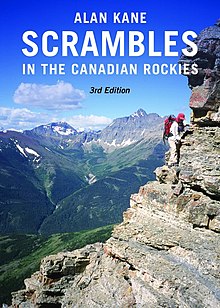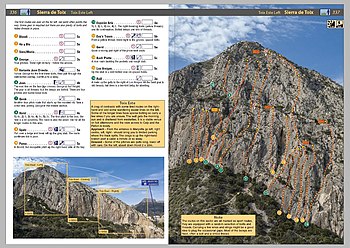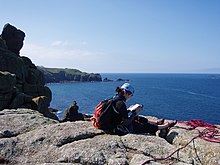
Climbing guidebooks are used by mountaineers, alpinists, ice climbers, and rock climbers to locate, grade, and navigate climbing routes on mountains, climbing crags, or bouldering areas. Modern route guidebooks include detailed information on each climbing route, including topo diagrams, route beta, protection requirements, and the ethics and style that are in place for a given climbing area (i.e can sport climbing bolts be used).
Modern climbing guidebooks are increasingly available in digital format, and even as searchable smartphone apps with extensive beta and three-dimensional diagrams of routes. Extensive online 'opensource' climbing databases of routes now exist, however, the publication of 'physical guidebooks' for technical climbing routes is still ongoing given the unique demands of climbing (with many having both a physical and online edition).
Climbing route guidebooks began to proliferate at the turn of the 20th century in Europe and became an important chronicle of the history and stories of climbing areas and routes (e.g. who made the first free ascent) and played an important part in promoting the sport of climbing and the attractiveness of particular areas. Certain notable guidebooks played an important role in standardizing the grading systems that are in use today.
Content and information
Main article: Climbing route § Details
Before discussing individual routes, a climbing guidebook will outline the history and current status of climbing ethics applicable for the location including for example whether the use of bolts for sport climbing is allowed, and other local customs (e.g. use if non-clean aid climbing techniques), and the legal position around access to the location.
Guidebooks can locate a given route by verbal description (for example: " start in the third left-facing corner below the large, orange roof, left of the route "Something Interesting"). Starting in the 1980s, a diagram style was developed, with detailed diagrams (or photographs) of the routes with the key obstacles and challenges encountered explicitly marked/overlaid, which came to be called "topos" (see image opposite).
Modern guidebooks include a range of standard details for each specific route, including the length of a route and its climbing grade. The description can also include varying amounts of information about how to climb the route, such as the location of the crux and any special techniques needed (i.e. bridging, laybacking, or the need for aid climbing)—when the information on 'how to climb' a route is very detailed it is collectively known as beta, and can affect the style of the ascent (i.e. onsighting). The guidebook may also include the type of equipment needed and particularly for climbing protection. In a definitive guide, the route's history (e.g. credits for first free ascents) would also be included.
In 2022, two Austrian climbers published Klimafreundlich Klettern (or Sustainable Climbing), a guidebook on the Tyrol whose climbing routes could be accessed via public transport or bicycle, thus reducing the carbon footprint of the climbers.
Sandbagging
The grading of modern climbing routes is increasingly concentrated around a small number of dominant systems, such as the Yosemite Decimal System and the V-scale in North America, and the French sport system and Font-scale in Europe. An aspect of climbing guidebooks is the consistency of applying these dominant grading systems with that of other climbing areas and guidebooks so that visiting climbers to an area can accurately assess the scale of a route's challenge. Where a guidebook's grades are materially 'easier' than what they should be so that the listed grades underestimate the challenge and difficulty of the routes, it is known as 'sandbagging'.
'Sandbagging' is a source of debate amongst climbers, some consider it a source of unnecessary danger to visiting climbers, while others consider 'sandbagging' a reflection of local customs and historical grading that should be preserved in guidebook grades. Certain climbing areas are notable for systemic sandbagging (i.e. most of the grades in their guidebooks understate the true difficulty of their routes), with examples in North America being Yosemite, Shawangunk Ridge (the "Gunks"), and Eldorado Canyon. Some guidebooks will try to alert the reader on sandbagged routes (e.g. "often considered sandbagged at the grade"), or with more subtle wordings to avoid upsetting local climbers such as "stiff at the grade".
Publication and authorship

Guidebooks may be compilations of selected popular or well-regarded routes (e.g. Fifty Classic Climbs of North America or Hard Rock), or exhaustive compilations of all known climbing routes in a region (e.g. the 512-page Lancashire Rock in Britain). The books may be published by national/regional mountaineering bodies (e.g. the British Mountaineering Council and Climbers' Club in Britain, the Club Alpino Italiano in Italy, or the Sierra Club in the US), by commercial publishers (e.g. Rockfax and Cicerone in Europe or Falcon Guides, Wolverine, and SuperTopo in the US), or self-published by local enthusiasts, which is how climbing areas get started.
Regardless of publication, in many cases, the authorship of the climbing guidebook will explicitly (i.e. named on the front cover), or implicitly (listed as contributors/advisors), include well-regarded climbers who are associated with the climbing area in question. There are however notable climbing guidebook authors who are not specifically associated with an area, but whose authorship and climbing insights are equally well-regarded, examples being Britain's Ken Wilson and America's Steve Roper, who wrote many notable climbing guidebooks for a wide range of locations and types of rock in their respective countries.
As a climbing area develops, new editions of the guidebook for the area will be published to capture the details of new climbing routes, to update details for existing routes, and in particular to show any change in the consensus grade of existing climbing routes. The task of re-grading existing climbs, and ensuring that the guidebook accurately and fairly reflects the assessments of respected climbers in the area, can be lengthy—and can lead to many heated debates amongst climbers, which need to be 'consensus-driven'. Between editions, 'new routes updates' are often held online.
Climbing databases
In recent years, many climbing guidebooks have been published in digital format, often for display in smartphone applications as apps. This medium offers the benefit of continuous updates, as well as rapid searching, and in some cases, GPS navigation and three dimensional diagrams. There are now several major online climbing route databases including 'theCrag.com' and 'MountainProject.com', however, climbing authors note that the need for 'physical guidebooks' that can be carried by climbers to (often) remote crags remains (many have physical and online editions).
Influence and notable books

Some of the earliest dedicated climbing guidebooks can be dated back to the mid-19th century and the Golden Age of Alpinism, with the British Alpine Club's Peaks, Passes, and Glaciers in 1859 being arguably being one of the earliest published guidebooks dedicated to climbing. Climbing guidebooks became an important part of developing the culture of climbing, and the promotion of the activity as a sport, and they became increasingly common by the turn of the 20th century in Europe and after World War Two in North America.
As well as promoting an area to outside climbers, guidebooks chronicle the history and stories of climbing areas and individual climbing routes, and delineate what is considered to be good and/or acceptable style in a particular area and what is not acceptable (e.g use of sport climbing bolts). There have been instances where local climbers have strongly objected to the publication of a guidebook due to differences in opinion on local climbing ethics, and/or the prospect of attracting increased visitors (e.g. at Pike's Peak in Colorado).
Certain guidebooks had a significant impact on the standardization of climbing and the adoption of grading systems in particular. For example, Steve Roper's 1964 big wall climbing guidebook, A Climber's Guide to Yosemite Valley, cemented the nascent Yosemite Decimal System as the dominant grading system in North America. Similarly, John Sherman's 1991 bouldering guidebook Hueco Tanks Climbing and Bouldering Guide introduced the V-scale to American bouldering, where it became the dominant system.
Climbing guidebooks that are considered historically notable include:
British Isles
- Some Gritstone Climbs (1913).
- Hard Rock (1974).
Continental European
- Peaks, Passes, and Glaciers. A Series of Excursions by the Members of the Alpine Club (1959).
- Alpine Club Guide (German: Alpenvereinsführer, commonly shortened to AV Führer or AVF).
- Guida dei Monti d'Italia (in English Guidebook to the Italian mountains).
North American
- A Climber's Guide to the Teton Range (1956).
- A Climber's Guide to Yosemite Valley (1964).
- Fifty Classic Climbs of North America (1979).
- Hueco Tanks Climbing and Bouldering Guide (1991).
Libraries and collections
Several mountaineering organizations maintain extensive libraries and collections of current and historical climbing guidebooks, including the British Mountaineering Council, who have been compiling an updated Bibliography of British and Irish Guidebooks (from 1894). The library of the American Alpine Club is also noted for its collection of climbing guidebooks. A noted online database of information on climbing routes—including verified ascensionists—is the late Elizabeth Hawley's, The Himalayan Database.
Awards
The Banff Mountain Book Festival has at times given a 'Best Guidebook Award' for outstanding guidebooks.
See also
References
- ^ Ryan, Mick; James, Alan (July 2002). How to write ... a MiniGuide (PDF). RockFax. pp. 1–15. Retrieved 26 August 2023.
- ^ Adamson, Michael (6 February 2009). "The Guidebook Odyssey – Unearthing the epic task of writing a guidebook". Climbing. Retrieved 26 August 2023.
- ^ Robinson, Doug (23 March 2023). "Guidebooks Are Still a Problem". Climbing. Retrieved 5 May 2024.
- "Sustainable climbing. The guidebook to Tyrol, Austria by Lena Müller, Deniz Scheerer". PlanetMountain. 6 May 2022. Retrieved 5 May 2024.
- ^ "What Is A Sandbag In Climbing? – Climbing Jargon Explained". Climber. 15 January 2021. Retrieved 6 May 2024.
- Schermerhorn, Eddie (9 September 2013). "Get Sandbagged! 7 Notoriously Tougher-than-Advertised Routes". Climbing. Retrieved 6 May 2024.
- Wright, Cedar (27 June 2023). "Cedar Wright on 'The Value of a Good Sandbag'". Climbing. Retrieved 6 May 2024.
- Drummond, Liz (2 March 2023). "Numbers Game: Classic Sandbags at 4 Historic Crags". Climbing. Retrieved 6 May 2024.
- D, Zak (22 August 2023). "What does sandbagging mean in climbing". HardClimbs. Retrieved 6 May 2024.
- Sagar, John (10 October 2019). "Guidebooks: What They Say vs. What They Mean Article". UKClimbing. Retrieved 6 May 2024.
- ^ Leonard, Brendan (12 April 2016). "Semi-Rad: In Praise of Guidebooks". Climbing. Retrieved 5 May 2024.
- ^ Grimes, Niall (12 December 2010). "How the BMC produces guidebooks". British Mountaineering Council. Retrieved 5 May 2024.
- Ward, Meghan (3 November 2010). "Kevin McLane's Canadian Rock: What It Takes to Write a Guidebook". Alpinist. Retrieved 5 May 2024.
- Gerry, Aaron (29 September 2023). "The Best Climbing Apps of 2023". Climbing. Retrieved 28 October 2023.
- Pardy, Aaron (17 July 2023). "Has the Future of Climbing Guidebooks Arrived in Squamish?". Gripped Magazine. Retrieved 3 November 2023.
- Buhay, Corey (23 August 2021). "From Climbing Partners to Bitter Enemies: In the Trenches of the Pikes Peak Bolt War". Climbing. Retrieved 5 May 2024.
- Boster, Seth (24 May 2021). "Controversial Pikes Peak guidebook set to be published". The Gazette. Retrieved 5 May 2024.
- ^ Kiester, Shey (12 June 2015). "A Climber's Guide to Yosemite Valley". Alpinist. Retrieved 5 May 2024.
- ^ Samet, Matt (24 March 2022). "10 Things You Didn't Know About Bouldering Grades". Climbing. Retrieved 1 September 2023.
- Douglas, Ed (28 June 2016). "Ken Wilson obituary". The Guardian. Retrieved 5 May 2024.
... and in 1974 published Hard Rock, among the most influential climbing books of the 20th century.
- Gates, Zoe (22 May 2017). "The 50 Classic Climbs of North America". Climbing. Retrieved 5 May 2024.
- "The Fifty Classic Climbs of North America List". Gripped Magazine. 29 October 2020. Retrieved 6 May 2024.
- Laeser, Luke (27 January 2006). "The Source – How Hueco and a guidebook gave birth to modern bouldering". Climbing. Retrieved 5 May 2024.
- Johnston-Smith, David (2024). "A brief introduction to the collecting of climbing guidebooks". Mountain Heritage Trust. Retrieved 5 May 2024.
- Moss, Alan (8 February 2012). "Are you a Fanatical Guidebook Collector?". British Mountaineering Council. Retrieved 5 May 2024.
- Grimes, Niall (12 June 2014). "British and Irish Climbing guidebooks – The 2013 Supplement". British Mountaineering Council. Retrieved 5 May 2024.
- Chua, Steve (30 November 2018). "Squamish Rockclimbs wins best guidebook award". Pique Newsmagazine. Retrieved 5 May 2024.
External links
- theCrag, Europe's largest online rock climbing route database
- MountainProject, North America's largest online rock and ice climbing route database
- VIDEO: How to use a climbing guide book, EpicTV (2016)
- VIDEO: How to use a climbing guide book, British Mountaineering Council (2017)
- Compiling A Climbing Guidebook, Irish ClimbingWiki (2023)
- Database of Climbing Guidebooks, UKClimbing Magazine (2024)